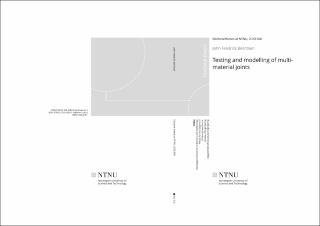| dc.description.abstract | The trend towards lightweight design in the automotive industry has led to increasingly optimal and complex structures, where fundamentally different materials are combined. An effective way of combining these would be to use adhesives as they are compatible with a large range of materials unlike traditional joining methods such as spot-welds. Adhesives exhibit beneficial properties including increased stiffness and improved energy absorption at the structure level. Further, adhesives are beneficial with respect to noise and vibration in addition to acting as a corrosion barrier. Therefore, adhesives have been increasingly used in the automotive industry. This makes adhesives a relevant topic to study for this thesis as there is generally a lack of understanding with respect to both the behaviour and the modelling of adhesives.
This thesis is split into two parts, one for each of the two selected adhesives for this study. The first part treats a semi-structural two-component polyurethane adhesive that has not been thoroughly studied before. In order to investigate the behaviour of the adhesive it was performed several material tests on bulk adhesive test specimens. For a selection of these tests, field data was obtained for both deformations and temperature. Scanning electron microscopy was also used to look at the failure surface of one of the specimens. Three configurations of single lap joints, using two types of fibre reinforce polymers as adherents, were tested to see the behaviour of the adhesive in a joint setting. To model the adhesive, the Bergström-Boyce model was chosen as it proved to be able to capture the key phenomena governing the response of the adhesive. In addition, a modification of the model was implemented as a user subroutine in Abaqus to better capture the viscous response of the adhesive. Both models were calibrated based on the material tests and validated against the notched tension tests.
The second part of the thesis studies a structural toughened epoxy adhesive. Bulk adhesive material tests, bonded cross tests, hybrid single lap joint tests, hybrid peel tests and hybrid component tests were performed as a part of a related thesis. Additionally, bonded component tests were tested as a part of this thesis. Data from the material tests were used to calibrate a previously implemented meso-scale polymer model for the adhesive. This model was then validated against the bonded cross tests, hybrid benchmark tests and the bonded component tests.
A partial virtual laboratory calibration procedure was developed in order to calibrate macro-scale material models for the adhesive. The method was based on simulating virtual benchmark tests using the meso-scale polymer model, then using the response of those simulations as target curves for reverse engineering of the macro-scale parameters. Three macro-scale models were calibrated using this approach including a baseline model MAT_240, a modified version of the baseline model and a Gurson-based cohesive zone model (GCZM). Additionally, the GCZM had to be implemented as a user subroutine in LS-DYNA. All three models were validated against the bonded component tests. There were made some adjustments to the calibration procedure, which led to new calibrations that were further validated against the hybrid benchmark tests and hybrid component tests. Finally, a study on the influence of the adherent properties on the calibrated material parameters of the macro-scale models were performed using the partial virtual calibration approach.
In conclusion, there was found a fundamental difference in the behaviour between the two adhesives that were studied in this thesis, which would imply significantly different modelling. The partial virtual laboratory calibration procedure was seen to give comparable results to what is obtained when using traditional calibration methods with physical experiments. Finally, the bending stiffness of the adherents were seen to have a larger influence on the calibrated m acro-scale properties of the adhesive than the material of the adherents. However, both were seen to have a minor influence overall based on the cases studied in this thesis. | en_US |
